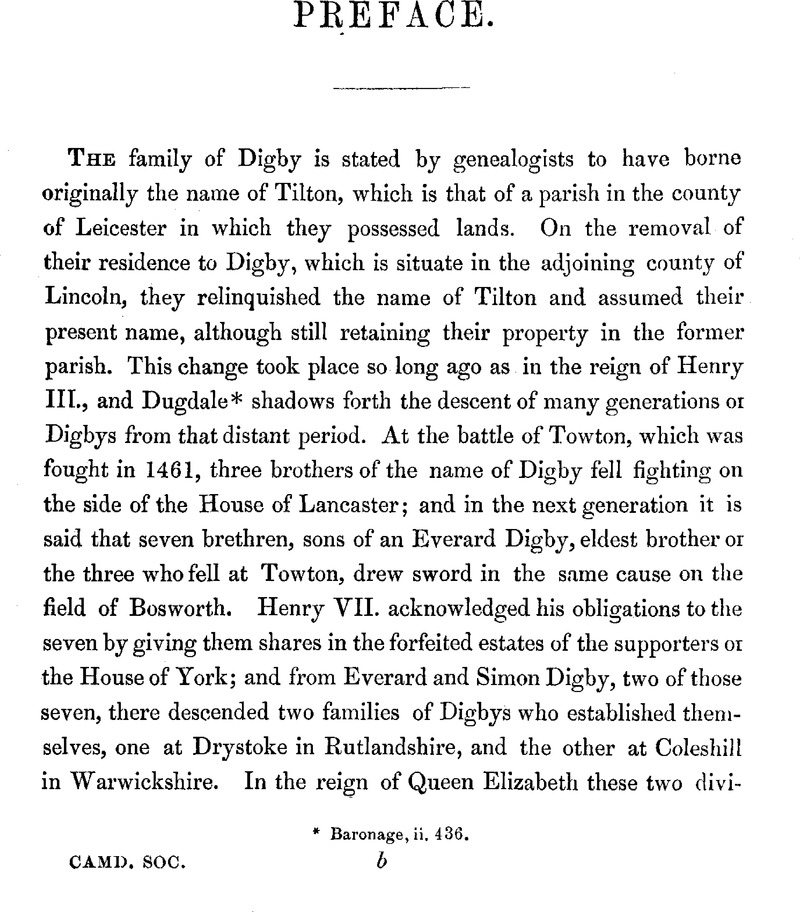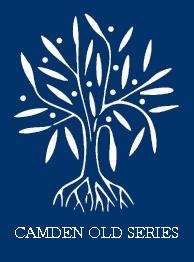No CrossRef data available.
Article contents
Abstract

- Type
- Preface
- Information
- Copyright
- Copyright © Royal Historical Society 1868
References
page v note * Baronage, ii. 436.
page vi note * Stowe's Annales, p. 739, ed. Howes.
page vi note † Lodge's Peerage, ed. 1789, vi. 288.
page vii note * There were six successive Everards as the heads of the house, in so many successive generations, with the single interposition of the Kenelm above alluded to. Lodge's Peerage of Ireland, ed. 1789, vi. 262.
page viii note * The Gunpowder Treason, ed. 1679, p. (55).
page viii note † They were discovered seventy years afterwards among the muniments of his son Sir Kenelm, and were published in The Gunpowder Treason, ed. 1679, pp. 167–170.
page viii note ‡ Jardine's Gunpowder Treason, ed. 1857, p. 147.
page ix note * Aubrey's Lives, ii. 328.
page ix note † There is a fine full-length portrait of Sir Everard at Peniarth ; the artist is unknown.
page x note * Before the change of style the 11th June, the day of St. Barnabas, was the longest day, a fact commemorated in an old popular invocation alluded to in Jonson's lines:
“Barnaby bright! Barnaby bright!
The longest day and the shortest night.”
page x note † Underwoods; Jonson's Works, ed. Gifford, ix. 47. Gifford sneers at Wood and Aubrey, as a couple of dreamers, not worth an argument.
page x note ‡ Biog. Brit. ed. Kippis, art. Sir Kenelm Digby.
page x note § Ath. Oxon. iii. 688.
page x note ║ The Dr. Napier, or perhaps rather Napper, who is here mentioned, was rector of Great Linford, Bucks. He was a pupil of Simon Forman, whose papers came into his hands.
On Dr. Napper's death the papers passed to his brother, Sir Robert Napper, a Turkey merchant, whose son Thomas Napper presented them to Elias Ashmole.—Lilly's Hist, ed. 1715, pp. 16, 52.
page xi note * I am indebted to the Rev. W. D. Macray, of the Bodleian Library, not only for most kindly pointing out to me this MS. but for a transcript of it, and for comparing the handwriting with a fac-simile of a portion of the Journal now published, with which it entirely agrees.
page xii note * Following the above passage there are various autobiographical memoranda, principally relating to sicknesses and accidents, which run on to the twenty-first year of Sir Kenelm's age, about which time the MS. was probably written, and the whole concludes, as if to make assurance upon the subject of the birthday doubly sure, with the following reiteration of the explanation as to the application of the new and old style to the scheme of nativity: “The places of the planets were collected out of the Ephemerides of Origanus, who in the first columne on the left hand setting downe the dayes of the moneth according to the Gregorian reformed account, they are thus the 20th day with the odde houres, to wch correspondeth on the right hand of the other page the 10th day according to the Julian old Kalendar.”
page xii note † Biog. Brit. ed. Kippis, v. 185.
page xiii note * Ath. Oxon. iii. 688.
page xiv note * Wharton's Troubles of Laud, p. 227.
page xv note * Wharton's Troubles of Laud, p. 610.
page xvii note * Ashmole MS. 174, fo. 77.
page xvii note † Ath. Oxon. iii. 688.
page xvii note ‡ Ibid.
page xvii note § Burton's Orat. Funeb. Thorn. Alleni, Lond. 1632, p. 6, quoted in Wood's Athense, ii. 542.
page xviii note * Wood's Athense Oxon., ii. 541, ed. Bliss.
page xviii note † Raising spirits was managed by these men with a facility which may well excite the envy of modern experimenters in that branch of inquiry. Allen's servitor at Gloucester Hall thought it for the credit of his master to assure “freshmen and simple people,” that he sometimes met the spirits coming up Allen's staircase like bees.—Aubrey's Lives, ii. 202.
page xix note * It is of him that a somewhat hackneyed story is related which we should not repeat but for the evidence it gives to the general idea entertained of the character of his pursuits. In his day pocket-watches were little known in remote districts. Visiting at the seat of the Scudamores in Herefordshire, Allen left his time-piece under his pillow. The chambermaids finding the thing, and hearing it cry tick ! tick ! concluded it was Mr. Allen's familiar. They determined to drown the infernal spirit, and canted it, with the tongs, out of the window into the moat. Unfortunately for their good intentions, the string by which it was suspended caught in an alder, and so, writes Aubrey, “the good old gentleman got his watch again.” (Aubrey's Lives, ii. 203.) A watch, in all probability the very subject of this anecdote, was bequeathed by Allen to Mrs. Martha Anian, wife of Dr. Thomas Anian.—Will proved at Doc. Com. 26 Nov. 1632.
page xx note * Clarendon's Autobiog. ed. 1843, p. 924.
page xx note † Private Memoirs, p. 80.
page xxi note * Ashmole MS. 174, fo. 77.
page xxii note * “Of Bodies and of Man's Soul,” 4to. Lond. 1669, p. 320.
page xxiii note * Sir Richard Wynne of Gwydir, afterwards Treasurer to Queen Henrietta Maria, was with Prince Charles in Spain, and wrote a narrative of what he observed in that country, which was printed by Hearne in his Historia Vitae Ricardi II. by a monk of Evesham ; Oxford, 1729. It was reprinted by Mr. Halliwell in his edition of the Autobiography of Sir Simonds D'Ewes, ii. 415.
page xxiii note † It may be agreeable to some of our readers interested in this curious case of vox oculis suhjecta, to read what succeeds the passage we have quoted above: “And his master himself would acknowledge that the rules of his art reached not to produce that effect with any certainty; and therefore concluded this in him must spring from other rules he had framed to himself.... The knowledge he had of what they said sprung from his observing the motions they made, so that he could converse currently in the light, though they he talked with whispered never so softly, and I have seen him, at the distance of a large chamber's breadth, say words after one that I standing close by the speaker could not hear a syllable of. But if he were in the dark, or if he turned his face out of sight, he was capable of nothing he said.”
page xxiii note ‡ Hardwicke's State Papers, i. 399, Letter of King James.
page xxiv note * Digby's Discourse on the Powder of Sympathy, p. 105.
page xxv note * Aubrey's Lives, ii. 331.
page xxv note † Private Memoirs, p. 201.
page xxv note ‡ Ibid. p. 202.
page xxv note § Ibid. p. 203.
page xxvi note * Private Memoirs, p. 205.
page xxvi note † Pp. 269, 289.
page xxvi note ‡ P. 276. He describes the same “error “in other places as “a little indulgency of a gentle nature which sprung from some indiscretion, or rather want of experience,” p. 151; and again, at p. 273, “the sweetness of her disposition is such that, through the A irulent malice of this age, it hath been the only cause of all her misfortunes.”
page xxvii note * Private Mem. p. 278.
page xxviii note * A late discourse by Sir Kenelm Digby, touching the Cure of Wounds by the Powder of Sympathy. Lond. 12mo. 1658, pp. 10,11. The Rev. S. Blois Turner, of Halesworth, F.S.A., very kindly presented the Editor with a copy of this book, which he has used on the present occasion. The early editions differ in some particulars from that of 1669.
page xxix note * The subject of Howell's cure by the Sympathetic Powder was treated by Sir Walter Scott in note W to the Lay of the Last Minstrel; also by Mr. Pettigrew, in his book on Superstitions connected with Medicine and Surgery.
page xxxii note * Coll. Sign Man. Car. I. vol. iv. No. 5.
page xxxii note † Ibid. No. 26; and see State Papers (Pub. Record Office) Dom. Car. I. vol. lxxxiv., Nos. 42, 43 and Nicholas's Letter Book, Dom. James I. vol. ccxix., pp. 51, 64.
page xxxiii note * Rot. Pat. 3 Car. I. p. 3, n. 20, dorso. Fœdera, xviii. 947.
page xxxiii note † State Papers, Dom. Car. I. vol. lxxxvii., No. 24.
page xxxiii note ‡ Ibid. vol. exv., p. 95.
page xxxiv note * Walkley's Cat. of Knights, 1658, p. 157.
page xxxv note * He was buried in the chapel of Jesus College. The history of this family has been pleasantly illustrated in the volume of Stradling Correspondence, ably edited by the Rev. J. M. Traherne, Lond. 12mo. 1840.
page xxxv note † Harl. MS. 7375.
page xxxvii note * A pedigree showing the descent of the MS. from Sir Kenelm to the present owner is given in the Additional Notes, p. 97.
page xxxviii note * Nouvelle Biographie Generale, xiv. 166.


